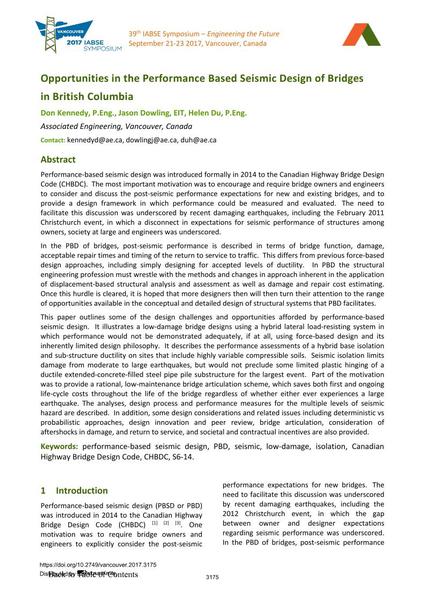Opportunities in the Performance Based Seismic Design of Bridges in British Columbia

|
|
|||||||||||
Détails bibliographiques
| Auteur(s): |
Don Kennedy
(Associated Engineering, Vancouver, Canada)
Jason Dowling (Associated Engineering, Vancouver, Canada) Helen Du (Associated Engineering, Vancouver, Canada) |
||||
|---|---|---|---|---|---|
| Médium: | papier de conférence | ||||
| Langue(s): | anglais | ||||
| Conférence: | IABSE Symposium: Engineering the Future, Vancouver, Canada, 21-23 September 2017 | ||||
| Publié dans: | IABSE Symposium Vancouver 2017 | ||||
|
|||||
| Page(s): | 3175-3182 | ||||
| Nombre total de pages (du PDF): | 8 | ||||
| Année: | 2017 | ||||
| DOI: | 10.2749/vancouver.2017.3175 | ||||
| Abstrait: |
Performance-based seismic design was introduced formally in 2014 to the Canadian Highway Bridge Design Code (CHBDC). The most important motivation was to encourage and require bridge owners and engineers to consider and discuss the post-seismic performance expectations for new and existing bridges, and to provide a design framework in which performance could be measured and evaluated. The need to facilitate this discussion was underscored by recent damaging earthquakes, including the February 2011 Christchurch event, in which a disconnect in expectations for seismic performance of structures among owners, society at large and engineers was underscored. In the PBD of bridges, post-seismic performance is described in terms of bridge function, damage, acceptable repair times and timing of the return to service to traffic. This differs from previous force-based design approaches, including simply designing for accepted levels of ductility. In PBD the structural engineering profession must wrestle with the methods and changes in approach inherent in the application of displacement-based structural analysis and assessment as well as damage and repair cost estimating. Once this hurdle is cleared, it is hoped that more designers then will then turn their attention to the range of opportunities available in the conceptual and detailed design of structural systems that PBD facilitates. This paper outlines some of the design challenges and opportunities afforded by performance-based seismic design. It illustrates a low-damage bridge designs using a hybrid lateral load-resisting system in which performance would not be demonstrated adequately, if at all, using force-based design and its inherently limited design philosophy. It describes the performance assessments of a hybrid base isolation and sub-structure ductility on sites that include highly variable compressible soils. Seismic isolation limits damage from moderate to large earthquakes, but would not preclude some limited plastic hinging of a ductile extended-concrete-filled steel pipe pile substructure for the largest event. Part of the motivation was to provide a rational, low-maintenance bridge articulation scheme, which saves both first and ongoing life-cycle costs throughout the life of the bridge regardless of whether either ever experiences a large earthquake. The analyses, design process and performance measures for the multiple levels of seismic hazard are described. In addition, some design considerations and related issues including deterministic vs probabilistic approaches, design innovation and peer review, bridge articulation, consideration of aftershocks in damage, and return to service, and societal and contractual incentives are also provided. |
||||
